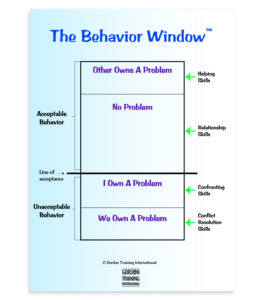Dr. Gordon quite openly admitted his first book was quite dull, too academic and he thinks it only sold a few hundred copies. BUT what it did, was set in motion the creation of a model of relationships that continues to change organizations—one leader, one team member, one manager—at a time.
So thank you for that, Dr. Gordon—we are grateful for your AH-mazing Behavior Window (what I like to refer to as the “Relationship GPS”) and all of the Gordon Model skills: Active Listening, I-Messages, Shifting Gears, Method III.
Below, Dr. Gordon shares the humble beginnings of what we now know as Leader Effectiveness Training:
I first called the model “group-centered leadership.“ As a graduate student at the University of Chicago, I was asked by my professor and mentor, Dr. Carl Rogers, to contribute a chapter to a book he was writing. I had become interested in the field of leadership while attending the National Training Laboratory (NTL), the birthplace of the “group dynamics” movement. Rogers saw that my model of leadership was an application of his new client-centered psychotherapy methodology.
His book was titled Client-Centered Psychotherapy: Its Current Practice, Implications, and Theory. It helped make Carl the most famous and respected psychologist in the world. “Group-Centered Leadership and Administration“ was the title of my chapter. I remember clearly the hours I spent reading everything I could find about leadership.
The beginning of the Gordon Model can be seen in these concepts described in that chapter:
• Leadership is a set of functions that are the property of the group and should be “distributed” to group members.
• The most effective leader is one who creates the conditions by which s/he will give up the typical leadership role and become more of a group member. Consequently, group members will then carry out some of the functions of the leader.
• Group problems require “participative group problem-solving.“
• Leaders should create the conditions in which all the members feel safe to communicate their ideas and feelings.
• Group-centered leaders need to set a model of attending to others by using “reflection of feelings and meanings” or “empathic listening,” the principal skill used by client-centered therapists.
• Group-centered leaders must convey “acceptance of the members’ communication.”
Before I earned my Ph.D. degree, I was given an appointment to the faculty of the Psychology Department at the University of Chicago. There I intensified my interest in leadership by conducting a leadership training program and doing weekly consulting with a small manufacturing company in Davenport, Iowa. These experiences motivated me to try writing my own book. It was very hard work for me, but I was confident that I was getting close to a definition of democratic leadership.
In that book, published in 1955, I added to this model the following concepts and methods:
• The “wisdom of the group,” my phrase to describe the creative resources of group members.
• A four-step* problem-solving process I developed to help groups tackle problems more systematically and effectively:
1. Recognizing and defining the problem
2. Diagnosing the problem
3. Making the decision
4. Accepting and carrying out the decision
*Now known as Method III, with six steps

